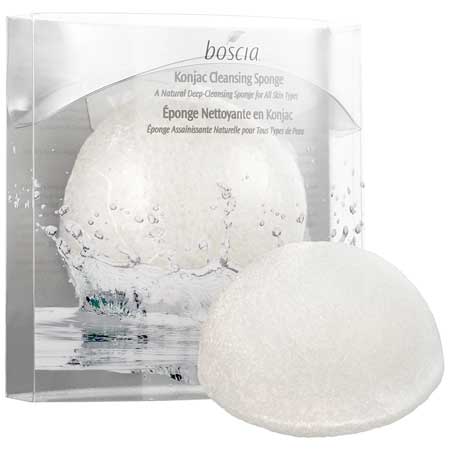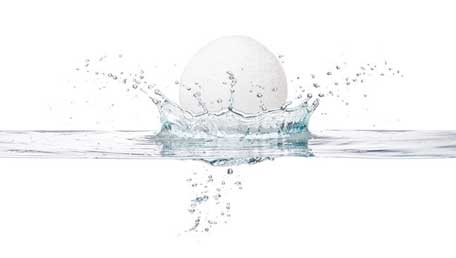The Clean-Up Crew — Will the Boscia Konjac Cleansing Sponge Become an Integral Part of your Face Washing Routine?


Admittedly, I’m almost unnaturally attached to my Clarisonic — so much so that, when it runs out of charge, I let out a freakishly high-pitched yelp that would make people think I’m the Wicked Witch of the West melting away. So, when I had the opportunity to test out the Boscia Konjac Cleansing Sponge ($18 at Sephora.com), I was at once excited and highly dubious. On the one hand, I wondered whether it would deliver on its promise to gently exfoliate, purify, and balance the pH level of my skin. On the other hand, I was skeptical about whether a sponge could deliver as deep a cleanse as the Clarisonic brush given that the latter actually relies on sonic technology and can therefore penetrate pores more effectively than any standard sponges or wash cloths.
But, then, the Boscia Konjac Cleansing Sponge isn’t billed as an ordinary sponge. A nod to Boscia’s Japanese heritage, this colorless, preservative-free and artificial fragrance-free sponge is made entirely of konjac root, a substance that has been utilized in both beauty and dietary regimens throughout Japan for over 1500 years, becoming particularly popular during the Edo period. The konjac plant, which is indigenous to tropical eastern Asia, has been an ingredient in many Japanese culinary creations. Its roots are the main ingredient in the dish known as konnyaku, also known as a yam cake, and in shirataki, noodles that are made by pushing the “cake” through a grid of sharp blades. The plant itself, meanwhile, is often used as a vegan gelatin replacement, appearing in dishes like oden.
In terms of its beauty benefits, konjac root has long been chewed with the hopes of detoxifying the body and even shedding pounds. Those who applied it topically, meanwhile, raved about its exfoliating properties. Nowadays, konjac root is incorporated into many of the facial massage accessories that have become popular in Korea, where V-sculpting is such a huge trend.
This particular sponge is made from the roots of konjac plants cultivated in the volcanic Jeju Island, one of the nine provinces of South Korea. Konjac root is an excellent source of: iron, which is essential to making skin appear healthy since a deficiency of this mineral can lead to unseemly pallor; copper, which helps to stimulate collagen formation; zinc, which can help control acne breakouts; vitamin A, an excellent anti-aging nutrient since it stimulates cellular growth; vitamin C, which brightens the complexion and helps to diminish the appearance of dark spots; vitamin E, a natural anti-oxidant that protects the skin against free radicals; vitamin D, which helps to heal acne breakouts, topical wounds, and other skin care conditions like psoriasis; vitamin B1, which helps to boost circulation and can give skin a glowing appearance; vitamin B6, used to treat skin inflammations; vitamin B12, which is vital in the production of red blood cells; and folic acid, believed to increase skin’s firmness.
Theoretically, then, Boscia’s Konjac Cleansing Sponge can gently exfoliate the skin and rid it of its impurities (which the root itself absorbs) while also refining your skin’s texture, boosting the complexion’s luminosity, and stimulating blood circulation, collagen production, and cellular regeneration.
But what about in reality? Well, let’s start with the basics.
When you first open the clear box in which the round, domed sponge is packaged and you hold the sponge within your hands, you might be alarmed by its dry and rough texture which is only slightly less abrasive than that of a pumice stone. I was definitely worried that the sponge would scrape away at my skin like sandpaper. But here’s the stunning part: when you rinse the sponge in warm water (as you’re advised to do before every single use), the sponge’s texture changes completely and it becomes significantly softer. I love how squishy it feels when I squeeze it in between my fingers and how, while generally soft, the fibers are still able to polish the skin, making every single cleansing an exfoliation. To use, you simply have to apply your favorite cleanser to the most sponge and, using circular motions, apply the cleanser all over your complexion. The sponge really allows the cleanser to lather up so don’t be surprised if your face washing routine becomes sudsier than ever! Once you’ve thoroughly cleansed your face, you simply have to rinse and prepare your sponge for future used by thoroughly washing it out and then hanging it to dry in a well-ventilated area (there’s a cotton thread attached to the sponge for precisely this purpose).
Initially, I loved how the Boscia Konjac Cleansing Sponge left my skin feeling squeaky clean. But then I started noticing some of the drawbacks to this product. For one, it takes forever to clean the sponge after each use. You can place the sponge under a hot water faucet and keep squeezing out any dirt, debris, makeup, and even leftover cleanser, but even after multiple tries, you’ll still feel like the sponge isn’t completely clean. It’s similar to the way one feels after using a kitchen sponge to wash dishes several times. After a few uses, you always wonder just how much bacteria lingers in that sponge. Well, the same is true for the Boscia Konjac Cleansing Sponge — after a few uses, I couldn’t help but wonder if, despite my best efforts, I was doing a subpar job of rinsing the sponge in between uses and hence simply taking whatever bacteria lingered therein and rubbing it right back on my face.
Here’s the other consideration: the konjac root is naturally alkaline and, since our skin tends to be slightly acidic, Boscia claims that the sponge will help to restore the skin to its proper pH balance. There is, however, a flaw in that line of thinking. There’s a good reason why skin is slightly acidic — our epidermis has an acid mantle that functions as a protective barrier, sealing in moisture and lipids while keeping harmful bacterias out. If your skin becomes too alkaline, it can actually lead to bacterial growth and, as a result, acne flare-ups. Also, when this acid mantle is attacked and skin becomes more alkaline, the loss of moisture can result in premature aging signs. On the flip side, if skin is too acidic, it will become overly sensitive and prone to irritation, but this is rather uncommon. Why is all of this important? Well, because most experts actually warn against using alkaline products on the skin — it’s one of the reasons why they’ve long encouraged women to stop washing with soap and, instead, rely on cleansers that won’s strip away the skin’s natural oils.
In my case, after about a month of using my Boscia Konjac Cleansing Sponge, I noticed I was starting to break out more often than ever before. At the time, I figured it had to be stress-related, but then I began to pay very close attention to my skincare habits. I stopped using the sponge for several weeks thereafter, switching back to my Clarisonic brush, and my breakouts started vanishing. I’d isolated the culprit: the sponge!
Now, my skin is typically on the dry side, which could be why an alkaline product would have an even more damaging effect on me than on someone with oily or combination skin. Nevertheless, I wouldn’t wholeheartedly recommend this to someone who, like me, has dry skin.
Hab=ve you tried the Boscia Konjac Cleansing Sponge? What was your experience like?







